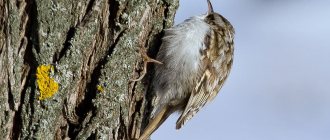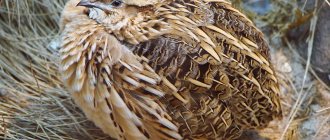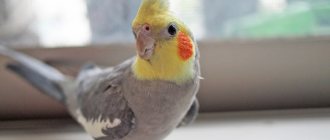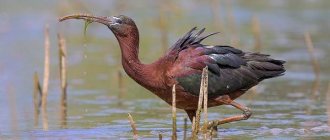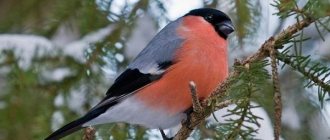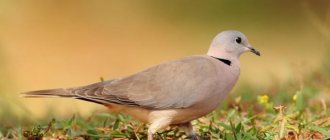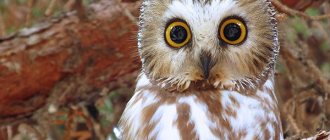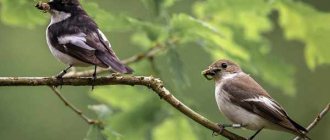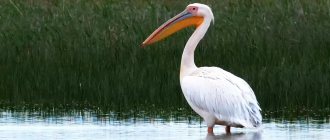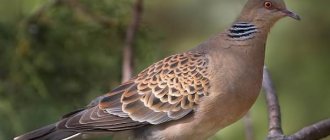- Wild animals
- >>
- Birds
The bearded vulture is a unique bird of its kind in the literal sense of the word, because this is the only species in the genus of bearded vultures. She is almost unlike other members of the hawk family. In general, the bird has a generally unusual appearance in comparison with other representatives of the fauna. Today it can be seen not only in its usual habitat, but also in many nature reserves in different countries. On this page we will tell you in detail about the most important moments in the life of a bearded man.
In this article:
|
Origin of the species and description
Photo: Bearded man
The very first bearded man to be discovered was Carl Linnaeus in 1758. He wrote about this bird in the tenth edition of his famous taxonomy, entitled Systems of Nature. In this work, Karl gave the bird its first Latin name - Vultur barbatus. Some time later, specifically in 1784, the German physician and chemist Gottlieb Conrad Christian Stor identified this species as a separate genus - Bearded Vultures (Gypaetus).
Interesting fact: in Russian the bird also has a second name - lamb. It is a translation from the Western European interpretation. There this species was so nicknamed because of the shepherds' idea that it kills sheep.
The bearded vulture is a large bird. Its length can reach 125 centimeters, and its weight ranges from 5 to 8 kilograms. The length of the wings is on average 77 centimeters, and their span is 290 centimeters. Their size can only be compared with vultures.
Emergency egg
Although bearded vultures raise one chick per year, they lay two eggs approximately one week apart, resulting in chicks hatching at different times and varying in size. The young are aggressive, and due to competition in the nest, the stronger chick harasses the weaker one in the first days of life, does not allow it to eat, and leads it to death.
The reason is that from the hunt the parents bring back enough food for only one chick. The second egg is a biological reserve if the first egg:
- not fertilized;
- the embryo dies;
- the chick does not survive the first few days.
Appearance and features
Photo: Bearded man
The bearded man has a very unusual appearance and color. For example, an adult bird has a light color only on the head, neck and abdomen. In some places the white color changes to a bright red hue. Black and white stripes run from the beak to the eyes, and under the beak itself there are a couple of black feathers, which at first glance may resemble a beard. The bearded man's iris is white or yellowish with a red border. By the way, the beak itself is gray in color. The back of the bird is covered with black and white feathers, and the tail is long and resembles a wedge in appearance. The bearded vulture's paws are also gray in color.
Juveniles of this species differ slightly from adults in their external features. Bearded vulture chicks are much darker. Their abdomen is light white, but the rest of the body is black and brown. She has a blue beak and green paws.
By the way, the bearded vulture is characterized by sexual dimorphism, that is, the female and the male do not differ in any way from each other in appearance and body size.
If you suddenly see this species in a zoo or in Russia, you may not be able to distinguish it from this description. This is easy to explain. Although we have described their plumage quite accurately, it can vary in color. A bird may, for example, have only a few white feathers, and all the rest will not be yellowish, but orange.
Glowing eyes, ruddy chest
Bearded men have amazing colors. The eyes are bright red when something piques their curiosity or they are excited. Juveniles have predominantly dark brown feathers. From the age of four, the head, chest and belly feathers turn white. Both sexes look for bodies of water that contain iron oxide in the sediment. Bathing turns the chest feathers a bright orange-red color. Whether this is a decoration, or whether the iron oxides protect the eggs from infections during the breeding season is unknown. Perhaps both explanations are correct, or there are other, unclear reasons.
Where does the bearded vulture live?
Photo: Bearded man
The habitat of this species of hawks is in principle similar to other representatives of the family. The bearded vulture can be found in such parts of the continent as Southern Europe, Eastern and Southern Africa, and Central Asia. A few years ago, a small number of birds were transported to the Alps to see how they would take root there. The experiment was successful, but the species still develops best in Europe. In Russia, the bearded vulture can be seen in Altai or the Caucasus.
The bearded vulture is essentially a mountain bird, so it is not afraid of high altitudes. It can live both high in the mountains and near the plains, but solely in order to be closer to its prey. The altitude of its stay on rocky terrain varies from 500 to 4000 meters. These are official data, but as it turned out long ago, the bird can live even higher than the stated numbers. Not long ago, a group of researchers discovered this species at an altitude of 7,000 meters above sea level. At higher elevations, birds choose more or less protected places, such as caves or depressions, to hide from possible precipitation or scorching sun.
What does a bearded man eat?
Photo: Bearded man
The diet of a bird like the bearded vulture is not particularly varied. For most of its life, a representative of the fauna feeds on dead animals, that is, carrion. In its diet, it is similar to several species from the hawk family. Birds usually find bones that people throw away after their dinner or feed on animals that have died of natural causes near their habitat.
Occasionally, a bearded vulture may eat a small mammal, such as a hare. This happens if the species is really hungry. From time to time, a bearded man may even try to grab a pet that has lost its vigilance.
Thanks to its strong flight feathers, the bearded vulture tries to push its prey from the height at which it may be located. After a small animal falls, a bird flies up to it to check if it is alive. Convinced of the opposite, the bearded man begins his meal.
Above we described most of the situations in which the bearded man attacks his prey, but his most favorite delicacy is animal bones, and mainly brain ones. Their stomach easily digests them due to their high acidity.
Midwinter breeding season
Bearded vultures breed from late December to late February. This somewhat special time is associated with the chickens' diet. They do not digest bones and need fresh meat in the first weeks of life. Incubation lasts approximately 55 days. The chicks hatch at the end of winter, when the carcasses of animals that did not survive the harsh season appear, and thus the parents provide the young with unrotted meat.
Features of character and lifestyle
Photo: Bearded man
Bearded vultures , although aggressive, still live in small flocks. They rarely have quarrels with each other. Thanks to their biological characteristics, they can fly so high that to a person standing on the ground, the bird may seem like just some incomprehensible point in the sky. The bearded man is such an excellent flyer that sometimes you can even hear the sound he makes with his feathers cutting through the air.
The bearded man's voice is very sharp. If you have not heard this bird scream before, then you are unlikely to be able to understand that it is this particular species. She makes sounds similar to whistling. They can be either loud or quiet. Scientists say that the voice directly depends on the specific mood of the bird at the moment.
Interesting fact: a bearded man is depicted on a 1994 Azerbaijan postage stamp.
When a bearded man notices his potential prey, he does not fall on it from a great height, like eagles. It begins to circle in the sky and gradually descends. The attack on the victim occurs from a fairly close distance to the ground.
The bird does not fall to the ground unless absolutely necessary. Due to its rather large and massive wings, takeoff becomes a rather problematic task for it. For her rest, she chooses various ledges on the rocks. From them the bird throws itself down and opens its wings for further flight without any problems.
Top 3: the most interesting facts about the bearded man
- Despite the fact that the range of this bird is very extensive, its status is defined as a rare species. The number of individuals is constantly decreasing, and in Bosnia, Syria and Serbia, bearded vultures are considered extinct animals. To maintain population sizes, the necessary conservation measures are being introduced and additional research is being conducted.
- The bearded man loves to feast on bone marrow, but it is not easy to get. To break the bone, the bird rises high into the sky and throws it to the ground. The skull is broken on the rocks, and the predator eats the contents along with bone fragments. The stomach of a scavenger can be very stretched and at the same time has increased acidity.
- Lambs are monogamous animals. Having created a couple, they live together until the end. They build their nest at an altitude of 2000-3,500 meters in caves, gorges, on mountain slopes and rock crevices. The foundation of the dwelling is constructed from branches and twigs of trees. Old bones left over from a meal are also used. The inside of the den is lined with grass, hair, and wool.
Social structure and reproduction
Photo: Bearded man
Unlike many birds, bearded vulture breeding occurs during the winter months. For nesting, these birds prefer high places of 2-3 thousand meters in the mountains, caves or rock crevices. Already in mid-December, bearded vultures occupy a fairly large area, reaching several square kilometers.
The material for the base of the nest is twigs and tree branches, and wool, grass, and hair are suitable for the lining. Already in January, the female is ready to lay a clutch, usually consisting of 1-2 oval eggs, the color of which has a whitish tint. The pattern of the eggs varies and brown spots are common. Sometimes they are monochromatic. It is mainly the female who incubates the eggs, but the male also takes part in this. After 53-58 days, the long-awaited chicks are born. Unlike adults, they are very vocal and often squeak.
Interestingly, birds are considered monogamous, so both parents also participate in raising the young. The male and female work together to obtain food for the children. They find bones, fly higher, break them into small pieces and bring them to the chicks. Thus, bearded vulture chicks live quite a long time - 106-130 days, and then their parents fly away from the nest, giving their offspring the opportunity to live independently.
Life at the Zoo
There are currently no bearded vultures on display at the zoo.
Some time ago we had a breeding pair; the female regularly laid eggs, which, by agreement, were transferred to a foreign nursery for breeding birds of prey.
One young couple now lives in our nursery, obtained from the International Center for the Breeding and Introduction of Bearded Vultures, where the Moscow Zoo once transferred eggs from our couple.
The bearded vulture's daily diet at the zoo consists of meat and rats, amounting to approximately 1 kg of meat and 1 rat per day.
Natural enemies of the bearded vulture
Photo: Bearded man
The bearded vulture is a very large and strong bird of prey, therefore, we can say that it simply does not have any natural enemies. Her only enemy is herself. This conclusion is explained by the fact that bearded vultures often feed on carrion, but not all dead animals are useful for them. Nowadays, people are rapidly developing infrastructure and paying little attention to their environment. Who knows what the little hare ate throughout its life. Its dead body may contain toxins and other harmful substances.
Also, a person can be considered one of the enemies of this individual. The bird often becomes a victim of hunters to create stuffed animals. People are developing more and more new territories, thereby shifting the natural range of many animals, including the bearded vulture. Not all birds are able to adapt to new climatic conditions, so many of them die. Based on this, we can conclude that man with his egoism is more of an enemy to birds in captivity than a friend.
Behavior, nutrition and lifestyle of birds
Habitat: mountainous terrain with numerous canyons, cliffs and gorges.
These birds are scavengers, but they prefer fresh meat rather than decomposed meat. The bearded vulture eats bones, tendons and even the skins of recently dead animals. In some cases, a predator attacks living birds, but this situation is not the norm, but the exception.
The bird got its name due to its plumage, similar to a beard.
The bearded man throws large bones down from a height, where they break on the rocks, after which the predator simply swallows them. These birds have a very powerful digestive system. One of my favorite dishes is marrow bones.
These predators also hunt turtles, they also lift them up, throw them onto rocks, and when the shell breaks, they eat the tender meat.
Population and species status
Photo: Bearded man
Meeting a bearded vulture is a fairly rare occurrence. This is currently influenced by many factors. For example, at the end of the 20th century, the food supply decreased due to a decrease in the number of wild and domestic ungulates. Birds often get caught in traps with little chance of getting out. Bearded vultures are more likely than other birds of prey to fall into this deadly trap. Just imagine, the population has declined so much over the last century that at the moment only a few dozen to 500 pairs live in each mountain range of Eurasia. Things are not so sad in Ethiopia, where the number of bearded vultures in their usual habitats ranges from one and a half to two thousand pairs. Even larger numbers of these rare birds can be found in some places in the Himalayas. Also, the decline in population was influenced by the human factor, which consisted in the growth and development of infrastructure, which is the construction of roads, houses, and power lines. One of the common problems bearded men have is colliding with power lines.
Due to all of the above factors, the range of birds began to decline significantly, which contributed to a decrease in population, this is reflected in many animals and is one of the most common reasons for the appearance of species on the verge of extinction. Usually, when one species goes extinct, other animals also suffer. So here, bearded vultures play an important role in the food chain and are the “orderlies” of nature. Therefore, not only the animals will suffer from the complete disappearance of this species, but also the surrounding area. This can lead to serious consequences, which is why it is so important to take care of the safety of this species.
The number of bearded men on the planet
Bearded vultures make nests right on the rocks.
Today, the population of bearded vultures is low - there are about 10,000 pairs of these birds living in the world. Human agricultural activity has led to a decline in the population. In addition, people shot these predators because they believed that they attacked livestock, but this opinion is erroneous.
Although the situation with the shooting of bearded vultures has now returned to normal, the population is greatly harmed by pesticides that penetrate into the stomachs of forest orderlies from the corpses of dead animals.
The usual nesting areas of birds are also shrinking. Bearded men can also die from collisions with high-voltage wires. Today, the population size is considered stable, but there is no upward trend.
If you find an error, please select a piece of text and press Ctrl+Enter.
